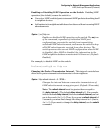
12-29
Configuring for Network Management Applications
LLDP (Link-Layer Discovery Protocol)
■ Receive only (rxonly): This setting enables a port to receive and read LLDP
packets from LLDP neighbors, and to store the packet data in the switch’s
MIB. However, the port does not transmit outbound LLDP packets. This
prevents LLDP neighbors from learning about the switch through that
port.
■ Disable (disable): This setting disables LLDP packet transmissions and
reception on a port. In this state, the switch does not use the port for either
learning about LLDP neighbors or informing LLDP neighbors of its pres-
ence.
SNMP Notification. You can enable the switch to send a notification to any
configured SNMP trap receiver(s) when the switch detects a remote LLDP
data change on an LLDP-enabled port (page 12-38).
Per-Port (Outbound) Data Options. The following table lists the
information the switch can include in the per-port, outbound LLDP packets it
generates. In the default configuration, all outbound LLDP packets include
this information in the TLVs transmitted to neighbor devices. However, you
can configure LLDP advertisements on a per-port basis to omit some of this
information (page 12-40).
Table 12-4. Data Available for Basic LLDP Advertisements
Data Type Configuration
Options
Default Description
Time-to-Live See note 1. 120 Seconds The length of time an LLDP neighbor retains the advertised
data before discarding it.
Chassis Type
2, 6
N/A Always Enabled Indicates the type of identifier used for Chassis ID.
Chassis ID
6
N/A Always Enabled Uses base MAC address of the switch.
Port Type
3, 6
N/A Always Enabled Uses “Local”, meaning assigned locally by LLDP.
Port Id
6
N/A Always Enabled Uses port number of the physical port. In the switches
covered in this guide, this is an internal number reflecting
the reserved slot/port position in the chassis. For more
information on this numbering scheme, refer to figures D-2
and D-3 in Appendix D, “MAC Address Management” of the
Management and Configuration Guide for your switch.
Remote Management
Address
Type
4, 6
N/A Always Enabled Shows the network address type.
Address
4
Default or
Configured
Uses a default address selection method unless an optional address is
configured. See “Remote Management Address”, below.
System Name
6
Enable/Disable Enabled Uses the switch’s assigned name.


















